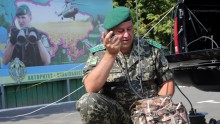A scheduled exercise for communication department heads of the State Border Service was held in Kyiv on August 6. Besides the theoretical lessons, the border guards got to see how the latest communication systems functioned. They have been recently inducted into service by our technicians. In particular, the platforms on display included mobile radio sets fielded on modified APCs and Cougar, Range Rover, and Volkswagen Amarok cars.
Mykolaiv Armor Repair Plant has joined the effort to field a communication set on a modified APC. This vehicle is unique in that, apart from the transmitters, it still has regular APC armament on board for self-defense. Meanwhile, car-based mobile radio sets were upgraded by the border service’s own specialists. These systems’ main advantage is ease of concealment.
“Through satellite communication stations we connect these vehicles to our telecommunications network,” deputy head of communications of the State Border Service Oleksandr Korol told us. “We provide phone connections and data transmission services as well. To compare them to previous systems, we needed 16 KAMAZ or ZIL trucks to deploy a full-fledged communication node before. Now, we can send just one of these machines. Via a satellite, it is plugged into the existing network and allows orders to be transmitted. Until recently, the deployment of a communication station took several hours, but these machines enable us to start transmitting in just 30 to 40 minutes. Modern technologies allow us to support radio conferences where we could support only two-way communication before.”
The vehicles displayed will be used in the border service’s regular activities as well as directly in the anti-terrorist operation area. To get acquainted with new equipment, border guards arrived from many parts of Ukraine. Captain 2nd Rank Denys Kachura is the chief of communications at Odesa Coastguard Detachment. The officer told us that although cars could only be used by land-based border guards, the principles on which they operate were suitable for maritime communications as well.
“We can see more modern stations, a variety of software, new satellite equipment here,” Captain Kachura reflected. “Although the platforms on display are all ground vehicles, we use identical systems operating on similar principles to protect the maritime economic zone. Of course, all these systems are much easier to work with than the ones we use. But most importantly, they provide a higher level of safety to their crews.”
Communication systems are major targets for the enemy. The Russian army is trying not only to destroy them, but to suppress transmissions as well. According to Korol, satellite communications are hard to interrupt. Even if an interruption of service occurs, soldiers can easily get out of trouble by using a technique known to all novice “hackers.” Korol told us as an open secret that a simple change of the IP address would get the system back to work, as if nothing had happened.







